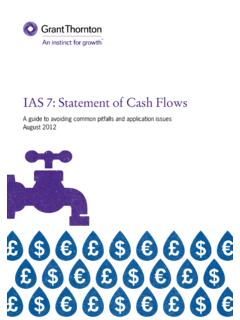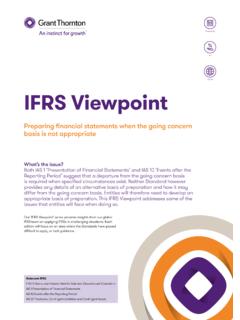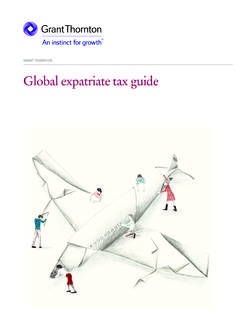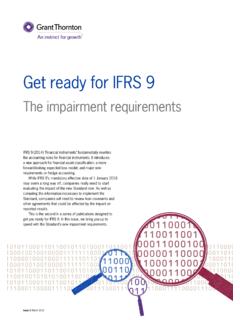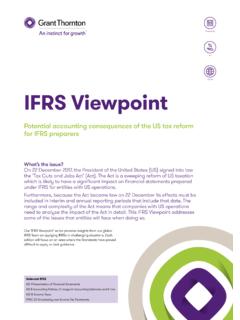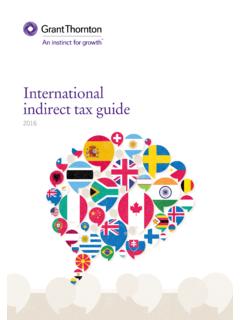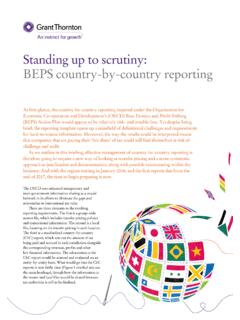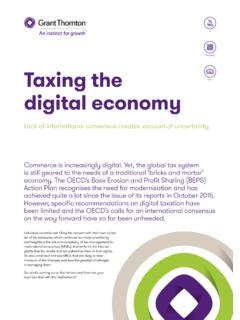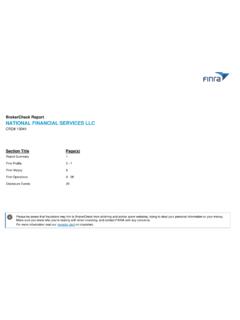Transcription of Deferred tax – a Chief Financial Officer’s guide to ...
1 Deferred tax a Chief Financial officer s guide to avoiding the pitfallsUnderstanding Deferred tax under IAS 12 Income TaxesFebruary 2013 Important Disclaimer:This document has been developed as an information resource. It is intended as a guide only and the application of its contents to specific situations will depend on the particular circumstances involved. While every care has been taken in its presentation, personnel who use this document to assist in evaluating compliance with International Financial Reporting Standards should have sufficient training and experience to do so. No person should act specifically on the basis of the material contained herein without considering and taking professional advice. Neither Grant Thornton International Ltd, nor any of its personnel nor any of its member firms or their partners or employees, accept any responsibility for any errors it might contain, whether caused by negligence or otherwise, or any loss, howsoever caused, incurred by any person as a result of utilising or otherwise placing any reliance upon this tax iDeferred taxPreparation of Financial statements under International Financial Reporting Standards (IFRSs) requires the application of IAS 12 Income Taxes (IAS 12).
2 Income taxes, as defined in IAS 12, include current tax and Deferred tax. For many finance executives the concepts underlying Deferred tax are not intuitive. Applying these concepts also requires a thorough knowledge of the relevant tax laws. IAS 12 takes a mechanistic approach to the computation but also requires significant judgement in some areas. For all these reasons, many Chief Financial Officers (CFOs) find that the calculation of a Deferred tax provision causes significant practical difficulties. Fortunately, the member firms within Grant Thornton International Ltd (Grant Thornton International) one of the world s leading organisations of independently owned and managed accounting and consulting firms have gained extensive insights into the more problematic aspects of accounting for Deferred taxes under IAS 12.
3 Grant Thornton International, through its IFRS team, develops general guidance that supports its member firms commitment to high quality, consistent application of IFRS. We are pleased to share these insights by publishing Deferred tax A Chief Financial officer s guide to avoiding the pitfalls (the guide ). The guide reflects the collective experience of Grant Thornton International s IFRS team and member firm IFRS experts. It addresses IAS 12 s key application issues related to Deferred taxes and includes interpretational guidance in certain problematic areas. Who should read this guideThis guide is intended for CFOs of businesses that prepare Financial statements under IFRSs. It illustrates IAS 12 s approach to the calculation of Deferred tax balances but is not intended to explain every aspect of the standard in detail.
4 Rather, it summarises the approach to calculating the Deferred tax balance in order to help CFOs to prioritise and identify key issues. The sections on avoiding the pitfalls will assist in understanding potential problem areas in order to know when to consult guide has been revised to reflect changes made to IAS 12 up to 31 December Thornton International LtdFebruary 2013 IntroductionOverview of the guide 1 Section 1: Calculating a Deferred tax balance the basics 3 Section 2: Allocating the Deferred tax charge or credit 12 Section 3: Disclosures 17 Section 4: Avoiding pitfalls the manner of recovery and the blended rate 22 Section 5: Avoiding pitfalls business combinations and consolidated accounts 28 Section 6: Avoiding pitfalls share-based payments 33 Section 7: Avoiding pitfalls recognition of Deferred tax assets 36 Section 8: Avoiding pitfalls other issues 40 Appendix A.
5 Glossary 47 ContentsDeferred tax: Overview 1 Overview of the guide This guide summarises the approach to calculating a Deferred tax balance, allocating the Deferred tax charge or credit to the various components of the Financial statements, sets out disclosure requirements and provides examples of the disclosures required by the standard. This guide also contains sections which cover some of the more complex areas of preparation of a Deferred tax computation, for example the calculation of Deferred tax balances arising from business combinations. The sections of the guide are as follows:Section 1: Calculating a Deferred tax balance the basics IAS 12 requires a mechanistic approach to the calculation of Deferred tax. This section looks at the definitions in the standard and explains, through the use of a flowchart, how to navigate through the requirements of IAS 2: Allocating the Deferred tax charge or creditThe second section of this guide summarises the approach to allocating the Deferred tax charge or credit for the year to the various components of the Financial statements.
6 The Deferred tax charge or credit for the year can arise from a number of sources and therefore may need to be allocated to: continuing operations within profit or loss discontinued operations within profit or loss other comprehensive income or equity 3: Disclosures IAS 12 contains a number of disclosure requirements. In this section these disclosures are listed and examples of how they can be presented are provided. These disclosures include: details of the components of the current and Deferred tax charge a reconciliation of the total tax charge to the profit multiplied by the applicable tax rate details of the temporary differences forming the Deferred tax asset or liability details of any unprovided Deferred tax nature of the evidence supporting the recognition of a Deferred tax 4: Avoiding pitfalls the manner of recovery and the blended rate Some assets or liabilities can have different tax effects depending on the manner in which they are expected to be recovered or settled.
7 For example, the sale of an asset can give rise to a tax deduction, whereas the use of that asset might not give rise to a tax calculation of the Deferred tax balance should take into account the manner in which management expects to recover or settle an asset or liability. In many cases this may be obvious, in others it may not, and in others the manner of recovery will be a mix of both use and sale. This section looks at the practical problems associated with calculating the impact on the Deferred tax balance based on the expected manner of recovery of an 5: Avoiding pitfalls business combinations and consolidated accountsBusiness combinations and consolidations give rise to complex Deferred tax accounting issues. This section considers a number of practical issues that can arise, specifically: whether Deferred tax should be recognised on intangible assets acquired in a business combination when Deferred tax arises on assets acquired in a business combination, whether the tax rate to be applied is that of the acquiree or acquirer when Deferred tax is recognised in a business combination, whether this leads to an immediate impairment of goodwill the provision of Deferred tax on unrealised intra-group profits eliminated on 6: Avoiding pitfalls share-based payments This section looks at two particular issues that arise in accounting for Deferred tax arising on share-based payments, specifically.
8 How to calculate the amount to be recognised in equity and the amount to be recognised in profit or loss how to account for Deferred tax on share based payments not caught by the measurement provisions of IFRS 2 Share-based Payment .Section 7: Avoiding pitfalls recognition of Deferred tax assets The recognition of Deferred tax assets is subject to specific requirements in IAS 12. Deferred tax assets are recognised only to the extent that recovery is probable. This section covers: the recoverability of Deferred tax assets where taxable temporary differences are available the length of lookout periods for assessing the recoverability of Deferred tax assets the recognition of Deferred tax assets in interim Financial 8: Avoiding pitfalls other issues This section is a summary of other issues which can arise in practice, namely.
9 Whether a particular taxation regime meets the definition of an income tax the tracking of temporary differences arising on initial recognition the accounting for changes in an asset s tax base due to revaluation or indexation of that tax base the treatment of Deferred tax on gains and losses relating to an available-for-sale Financial asset reclassified to profit or loss accounting for Deferred tax on compound Financial instruments reflecting uncertainty over whether specific tax positions will be sustained under challenge from the relevant tax authorities. AppendixAppendix A to this guide provides a glossary of key terms used in IAS 12. 2 Deferred tax: OverviewDeferred tax: Section 1 3 Section 1: Calculating a Deferred tax balance the basicsSummary of approachIAS 12 requires a mechanistic approach to the calculation of Deferred tax.
10 This section looks at the definitions in the standard and explains, through the use of a flowchart, how to navigate through the requirements of IAS following flowchart summarises the steps necessary in calculating a Deferred tax balance in accordance with IAS 1 Establishing the accounting base of the asset or liabilityStep 2 Calculate the tax base of the asset or liabilityIf there is no difference between tax and accounting base, no Deferred tax is required. Otherwise go to step 3 Identify and calculate any exempt temporary differencesStep 4 Identify the relevant tax rate and apply this to calculate Deferred taxStep 5 Calculate the amount of any Deferred tax asset that can be recognisedStep 6 Determine whether to offset Deferred tax assets and What is the accounting base? The accounting base of an asset or liability is simply the carrying amount of that asset or liability in the statement of Financial position.

